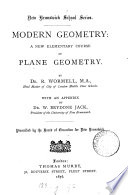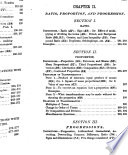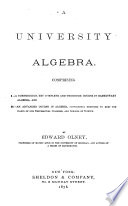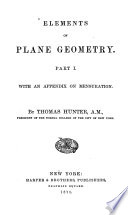 | William Guy Peck - Algebra - 1875 - 348 pages
...a + c + e+g+&c. a &c, : b + d+f+h + &c. :: a:b; (11) hence, the following principle : 10°. In any continued proportion, the sum of all the antecedents is to the sum of all the consequents, as any antecedent is to the corresponding consequent. ь d " bc = ad. a — c' b a = ê' " be = «/•... | |
 | Horatio Nelson Robinson - Algebra - 1875 - 430 pages
...proportion, consisting of three or more equal ratios, then either antecedent will be to its consequent, as the sum of all the antecedents is to the sum of all the consequents. Suppose a:b=c:d — e:f = g:h=, etc. Then by comparing the ratio, a : b, first with itself, and afterward... | |
 | Benjamin Greenleaf - Geometry - 1875 - 204 pages
...THEOREM X. 115. If any number of magnitudes are proportional, awy antecedent is to its consequent as the sum of all the antecedents is to the sum of all the consequents. Let A : B : : C : D : : E : F; then will A : B: :A+C+E: B-\-D + F. For, from the given proportion,... | |
 | William Guy Peck - Conic sections - 1876 - 412 pages
...of a proportion may be multiplied or divided by the same quantity. PROPOSITION VIII. THEOREM. In a continued proportion, the sum of all the antecedents is to the sum of all the consequents as any antecedent is to the corresponding consequent. Assume the continued proportion, z 7 /• * df /i\... | |
 | Richard Wormell - 1876 - 268 pages
...B + F. -F; .-. A + E : В + F = E : F = С: D. THEOREM LXX. If there be any number of equal ratios, the sum of all the antecedents is to the sum of all the consequents as either antecedent is to its consequent. Let A : В = С : D = E : F. By Theorem LXIX., A + E:B + F... | |
 | Edward Olney - Algebra - 1877 - 466 pages
...(6 + d +/+ & + & +, etc.) : : a : 6, or c : d, or e : /, etc. That is, in a series of equal ratios, the sum of all the antecedents is to the sum of all the consequents, as any antecedent is to its consequent ., aa SOLUTION. =- = r- or 06 = 60, oo ac . — = -T or ad = be,... | |
 | Elias Loomis - Conic sections - 1877 - 458 pages
...IX. THEOREM. If any number of quantities are proportional, any one antecedent is to its consequent as the sum of all the antecedents is to the sum of all the consequents. Let A:B::C:D::E:F,etc.; then will A:B:: A+C+E: B+D+F. For,since A:B::C:D, we have A x D=B x C. And,... | |
 | William Frothingham Bradbury - Algebra - 1877 - 302 pages
...THEOREM XII. 213. If any number of quantities are proportional, any antecedent is to its consequent as the sum of all the antecedents is to the sum of all the consequents. Let a : b = c : d = e :f Now ab = ab (1) and by Theorem I. ad = be (2) and also af=be (3) Adding (1),... | |
 | Edward Olney - 1878 - 360 pages
...: c + d :: a— e : Ъ— dt 72. Сов. — If there be a series of equal ratios in the form of a continued proportion, the sum of all the antecedents is to the sum of all the consequents, as any one antecedent is to its consequent. DEM. — If a :b : : с : d : : e :f: :g :n, etc., a + c +... | |
 | Thomas Hunter - Geometry, Plane - 1878 - 142 pages
...the squares of those sides. 1. Since the polygons are similar, AB: FG:: BC:GK::DC:LK, etc. Now, as the sum of all the antecedents is to the sum of all the consequents as any one anteB * a sequent, AB+BC+DC cedent is to any one con+ ED + AE:FG+GK + KL + LH + FH::AB:FG;... | |
| |